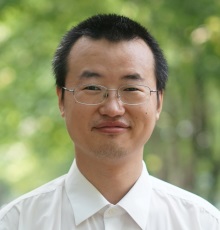Fenton-like techonology 类芬顿技术
Industrial Wastewater Pollution Control
With the rapid development of the world economy, environmental pollution and energy shortage became a global problem. At the same time, with the rapid development of coal, petroleum, pharmaceutical, printing and dyeing, paper making and other industries, the discharge of persistent organic wastewater is increasing. The large amount of the toxic, persistent organic wastewater is widely distributed on soil, water, animals, plants and human, and became great threat and listed as the key control object. So it is an important research topic in the field of environmental protection and wastewater treatment. For instance, it is difficult to degrade organic industrial wastewater containing toxic aromatic compounds. The traditional physical, chemical and biological methods are difficult to meet the technical and economic requirements of the purification treatment. Therefore, the development of new advanced oxidation technology to deal with this kind of wastewater has become a hot research topic.
· The electrocatalytic advanced oxidation processes
Electrocatalytic oxidation method is a green chemistry technology that belongs to a kind of advanced oxidation process (AOP). It utilizes the electrocatalytic properties of the electrode material to directly oxidize organic pollutants, or to produce free radical with strong oxidation capability to oxidize organic pollutants in wastewater indirectly, and ultimately achieve the complete degradation of organic pollutants. The electrode material is the core of the electrochemical oxidation process for the treatment of the bio refractory organic wastewater. The research and development of high performance electrode material has been the focus of electrochemical water treatment technology. Besides its high electrocatalytic activity and coulomb efficiency, good stability and high corrosion resistance are also important indicators for superior electrode materials. Traditional electrocatalytic oxidation technology suffers from the problems of high energy consumption and prone to deactivation of electrode. In view of the problems, our research focuses on improving electrode electrocatalytic performance and development of new carbon based composite electrode materials.
Spectroelectrochemistry is one of the most active electrochemical research fields at present. It combines the advantage of electrochemical technology that is easy to control the surface properties and reaction energy, and of vibration spectrum that is powerful to analyze the nature of the electrode-solution interface and chemical bond from the microscopic point of view. The current application of in-situ method is to study the characteristics of the samples at the molecular level, while maintaining the original environment of the reacting system. We will use the method of in situ FTIR spectroscopy to analyze the catalytic mechanism of different catalytic electrodes, and the degradation mechanism of different types of refractory organic pollutants.

Fig1. Electrocatalytic oxidation process for degradation of refractory organic pollutant.
· Nanoscale Zero-valent Iron (nZVI)
Nanoscale zero-valent iron (nZVI) has attracted considerable research interest for environmental remediation because it can rapidly transform a variety of heavy metal and chlorinated organic contaminants through chemical reduction processes. However, there are challenges associated with efficient utilization of nZVI particles, which include the loss of electrons due to reaction with water and the passivation of nZVI surface due to formation of oxide layers, leading to reduced reactivity toward target contaminants. Furthermore, the attractive forces that exist between nZVI particles lead to significant aggregation and pose a challenge to their transport in contaminated aquifers during in situ remediation. FunMat group will target these issues to improve the reaction efficiency as well as the applicability.
· Photocatalytic Oxidation technology
In recent years, photocatalytic technology based on semiconductor materials provides us an effective way to effectively control the environmental pollution, by efficient utilization of solar energy. The heterogeneous photocatalysis based on semiconducting metal oxide catalyst, can directly utilize sunlight to drive the catalytic activation, and catalyze a series of oxidation – reduction reaction, which could be the ideal environment pollution control technology. This technology can be applied in many aspects such as deep oxidation of various organic pollutants, reduction of toxic heavy metal ions and also anti-bacterial, anti-virus applications.

Fig 2. Crystal structure of photocatalysts: rutile, anatase and brookite of TiO2.
废水处理高级氧化技术
随着世界经济的快速发展,出现了环境污染和能源短缺的全球性问题。同时,随着煤、石油、制药、印染、造纸等工业的迅猛发展,难降解有机工业废水的排 放量日益增加。这类有机废水排放量大、降解困难、毒性较大、分布广泛,对土壤、水体、动植物及人体产生极大危害,被列为重点控制的对象,也是环境保护及废 水处理领域的重要研究课题。例如,难降解有机工业废水中大多含有有毒芳香族化合物,传统的物理、化学和生物方法难以满足净化处理在技术和经济上的要求。因 此,开发经济有效的新的高级氧化技术来处理这类废水已成为目前的研究热点。
· 电催化高级氧化技术
电 催化氧化法作为高级氧化法的一种,是通过具有电催化性能的电极材料表面直接氧化有机污染物,或者电极材料通过电化学作用产生具有强氧化能力的自由基基团间 接氧化废水中的有机污染物,最终使其完全降解的绿色化学技术。在电化学氧化处理生物难降解有机废水体系中,电极材料是“核心”。高性能电极材料的研究开发 一直是电化学水处理工艺的研究重点。除了具有较高的电催化活性和库伦效率以外,在废水电解处理过程具有较好的稳定性和抗腐蚀性也是电极材料的重要指标。 传统电催化氧化技术存在能耗高、电极易失活等问题,影响其实际推广应用。针对以上问题,我们将重点开展电极电催化性能以及新型碳基复合电极材料的研究。
光 谱电化学是目前电化学中最活跃的研究领域之一,它具有电化学技术易于控制表面性质、反应能量的优点,又具有光谱易于从微观角度观察电极-溶液界面上有关结 构和键合的性质。当前应用的原位法是在保持研究体系原有环境的基础上从分子级水平研究电极-溶液界面上吸附物、双电层以及靠近电极的反应扩散层中样品的特 性。我们将使用原位红外光谱电化学表征手段,深入解析不同催化电极的催化机理以及对于不同类型难降解有机污染物的降解机理。

Fig1. Electrocatalytic oxidation process for degradation of refractory organic pollutant.
· 纳米零价铁
近 年来,环境研究者们渐渐对纳米零价铁(nZVI)在环境治理中的应用产生了浓厚的兴趣。nZVI可以迅速地将多种重金属离子和氯代有机污染物通过化学还原 作用消除其环境毒害。然而,目前在有效利用nZVI颗粒方面仍存在诸多挑战,其中包括nZVI与水反应与NZVI表面形成氧化层钝化而导致的电子损耗,从 而降低对目标污染物的反应效果。此外,nZVI颗粒之间存在吸引导致了显著的团聚,对污染地下水原位修复时nZVI的有效空间转移提出了挑战。 funmat组将针对以上科学问题展开研究,力求提高其反应效率及其环境适用性。
· 光催化氧化技术
近 年来,以半导体材料为催化剂的光催化技术,为我们提供了一种有效治理环境污染和高效利用太阳能的有效途径。以半导体氧化物为催化剂的多相光催化反应过程, 可直接利用太阳光为驱动来活化催化剂,从而发生一系列氧化-还原反应,成为理想的环境污染治理技术。这种技术能够深度氧化各种有机污染物,还原重金属有毒 离子以及抗菌、杀毒等多方面的应用。

Fig 2. Crystal structure of photocatalysts: rutile, anatase and brookite of TiO2.

